Astrotec Lyra Collection 32ohm Review – Superior Expression

Pros –
Class-leading design & build, Terrific treble extension for an earbud, Great soundstage
Cons –
Not especially transparent, Price prohibitive
Introduction –
The early 2010’s marked the transition of hybrid driver in-ears from proof of concept to affordable luxury. It was during these formative years that we saw some small OEMs rise to become the industry titans they are today and others fall into obscurity. And among them was Astrotec, a small but promising company with huge aspirations. They became most renowned for pioneering fresh designs and innovative technologies, and the original Lyra was a testament to that sentiment. At the time, affordable hybrids were just popping onto the market and earbuds were mostly confined to complimentary units provided with MP3 players.
And it was within such a market that Astrotec launched a triple hybrid driver earbud with a premium $165 USD asking price, it was disturbing and unheard of. Astrotec have since taken a small hiatus from the international market but have recently re-emerged with a strong range of earbuds and in-ears. The Lyra Collection is perhaps most outstanding, representing absolute refinement of the original Lyra and the pinnacle of earbuds with its hefty $300 USD asking price. Once again, Astrotec deliver an innovative package at an adventurous price, but can their earbud complete amongst the most expensive and prestigious on the market? Let’s find out.
Disclaimer –
I would like to thank Astrotec very much for their quick communication and for providing me with the Lyra Collection for the purpose of review. All words are my own and there is no monetary incentive for a positive review. Despite receiving the earbuds free of cost, I will attempt to be as objective as possible in my evaluation.
Accessories –
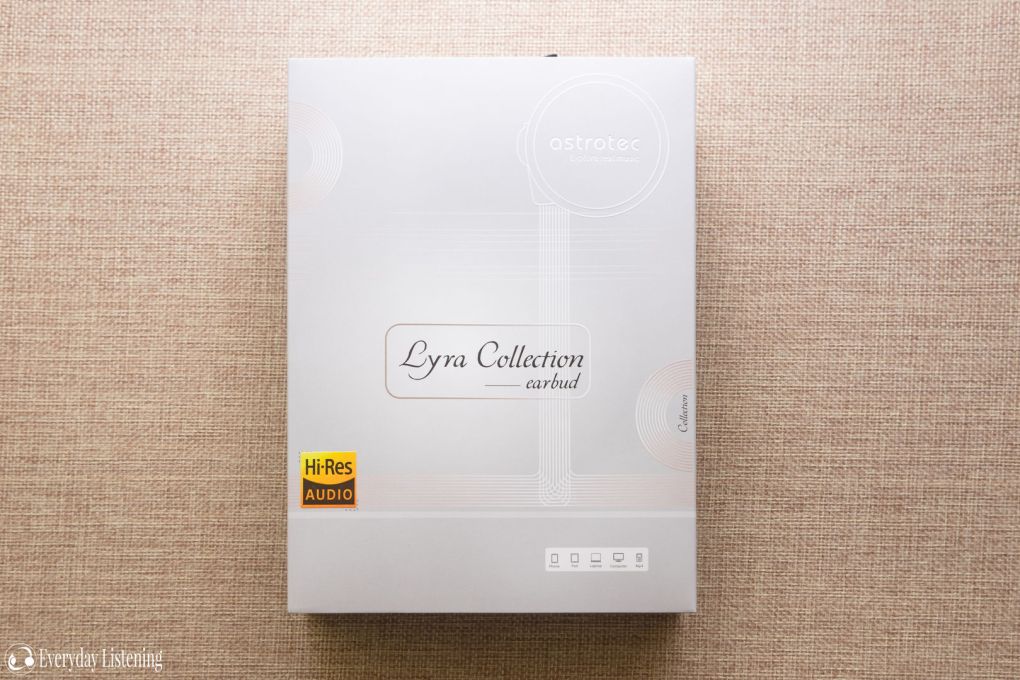
The Lyra Collection stuns with its premium and, dare I say fashionable unboxing. A minimalist vectored outer sleeve makes way for a fabric textured inner hard-box that magnetically latches open to reveal a complimentary message from Astrotec.
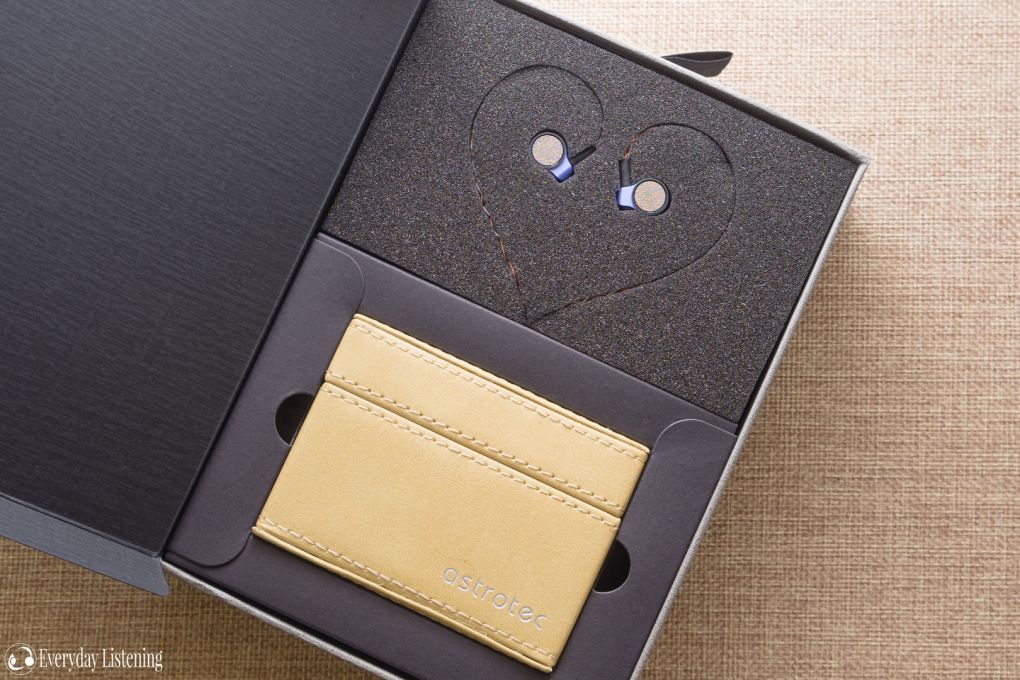
Just below lie the earbuds and accessories within protective foam and card, the Lyra’s are stored in the shape of a heart, contouring the cable to better conform to the ear. Below is a beautiful leather carry case. It’s well-sized and feels both solid and protective with a soft interior and magnetic lid.

Astrotec also provide buyers with a leather cable organiser and an abundance of covers to tailor the fit and sound to user preference. The Lyra is packaged with 3 pairs of thin donut foams, 3 sizes of silicone covers with Bose-style fins and a pair of earguides. I was especially impressed by the foams as most included foams have uneven cutouts, the Astrotec units are likely custom ordered.
Design –
The Lyra Collection is a gorgeous earbud that makes an instant statement within a sea of generic mediocrity. Where most earbuds assume a basic plastic shell, the Lyra instead employs meticulously finished aluminium enclosures that even rival 1More’s high-end products in fit and finish. Top this off with one of the best cables that I’ve ever handled regardless of price and this earbud does a lot more than most to earn its asking price.

The housings themselves are smoothly sculpted and ergonomic, designed to be comfortable both with and without foam covers. They employ an aluminium construction with a satin blue finish over the brushed silver of the original Lyra. That said, like 1More’s purple/gold concoction, it’s an interesting look executed through good taste. Otherwise, the Lyra Collection does very much resemble the original in design with the same micro-mesh vents at the rear and checkered metal grills traced by rubber rims at the front.
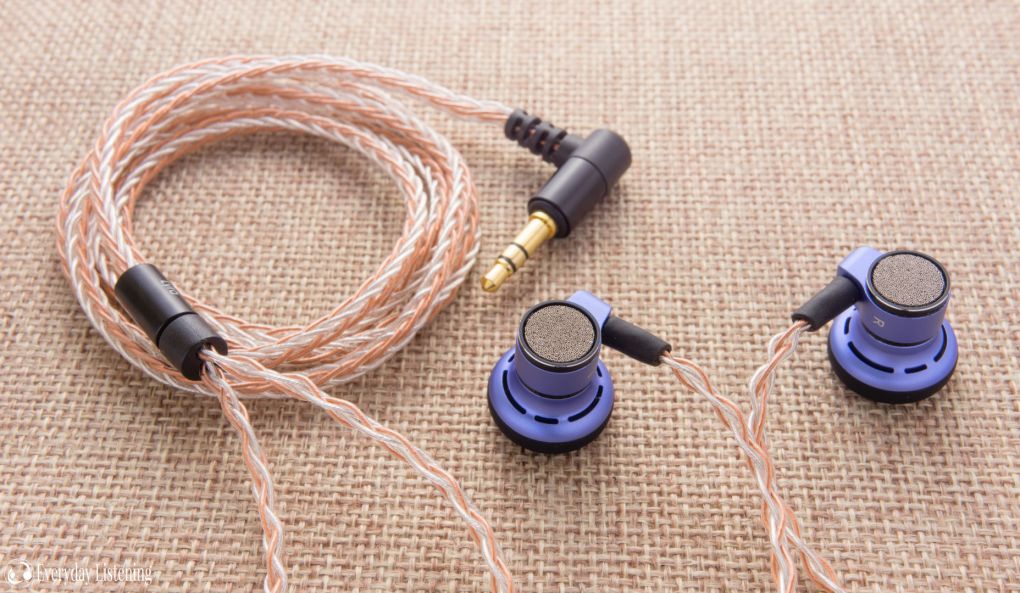
In wear, the very rounded Lyra Collection produces an ergonomic fit. And, being an earbud, it forms minimal seal with no pressure or isolation as a result. Still, this does contribute to their comfort, with no fatigue or hotspot formation during extended listening. They aren’t the most compact earbud, protruding a fair amount from the ear. This makes them somewhat uncomfortable for sleeping with, but their over-ear design is very stable despite their shallower fit.
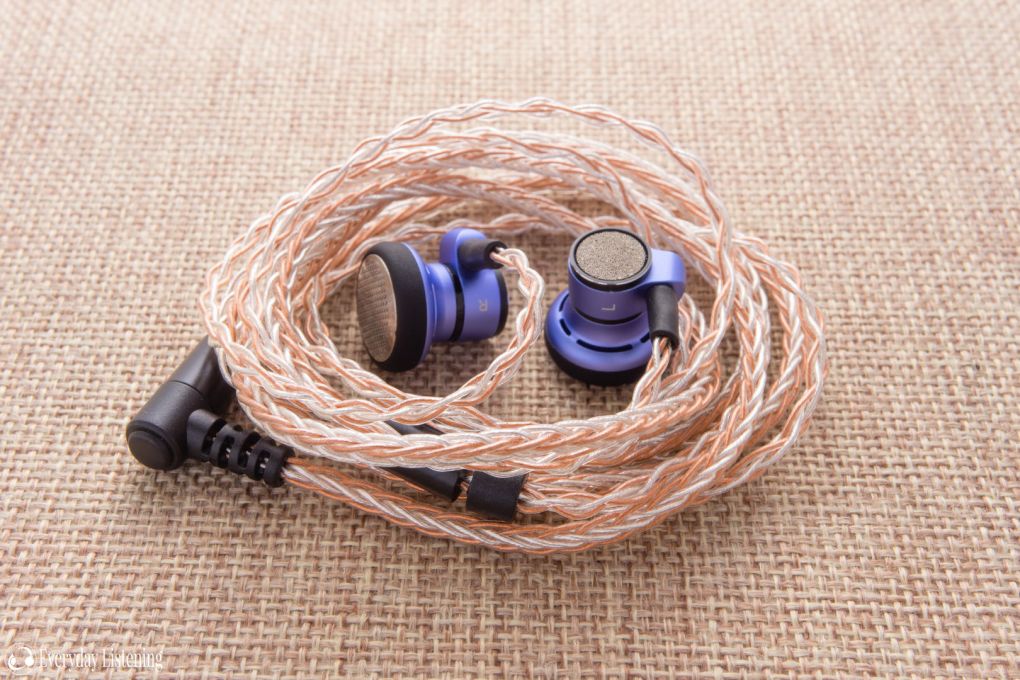
The Lyra Collection has one of the best cables I’ve ever handled. It is fixed, but I can’t imagine anyone wanting to swap out the 6N OCC copper/silver hybrid that comes attached. It’s 8-core braid is even and incredibly supple with zero memory and absent microphonic noise. Furthermore, the cable has a terrific right-angle 3.5mm plug that is case-friendly and well-relieved. The cable is continuous through the y-split for increased reliability and terminates with a beefy rubber sheath at the earpieces.
Sound –
The Lyra Collection utilises a single 15mm dynamic driver over the triple driver setup of the original. That said, Astrotec have focussed more intensely on the surrounding acoustics, with extensive modification to the chambers creating a superior sound. In addition, the Collection implements an irregular copper filter that reduces internal refractions to deliver a cleaner sound. I put the Lyra Collection through 150hrs of burn-in to ensure that they were performing optimally during review.
As the Lyra Collection was designed to be used with foam covers, the following comments will be with donut foams equipped. I found that they slightly smooth off lower-treble and extend and lift bass. Without foams, the earbud still sound quite natural but they become notably brighter. Those wanting more treble attack will find a more agreeable experience without covers.
And, much like the similarly fitting Ourart Ti7, the Lyra Collection’s sound can also be slightly altered by varying its fit depth. Pushing the earbuds deeper into the ear netted a darker, fuller sound with greater bass impact. Conversely, letting the earbuds sit loosely in the outer air granted them with increased clarity and air; and I found the generally warmer Lyra Collection to sound most balanced when loosely fit.
Tonality –
The Lyra Collection isn’t neutral, but it does possess great balance from top to bottom. To further clarify, each frequency range possesses the potential to draw equal attention but its signature remains clearly sculpted. In particular, the Lyra Collection has slightly elevated mid and upper-bass, increasing vocal density, and similar emphasis within the upper-midrange and treble enhancing clarity and air.
Bass –
Bass forms the foundation of any sound and it’s for this reason that many ill-sealing earbuds fail to deliver a convincing image. Luckily, the Lyra Collection is among the best earbuds I’ve heard in terms of low-end balance and detail. With foams, the earbud delivers an agile bass response that prioritises focussed mid-bass attack over sub-bass slam. Its sub-bass extension is only modest, delivering softer impact and rumble, but the Lyra sounds more linear through its lower frequencies than the vast majority of earbuds. It has a slightly bolstered mid-bass response, creating its warmer tone, and a similar upper-bass elevation that grants the Lyra’s midrange with its syrupy vocal body.
That said, the Lyra’s bass emphasis is more subtle than most, and its greater linearity from mid-bass to lower-midrange enables high bass definition. This is augmented by quicker transience and great tightness that produce textured notes and an articulate listen. Though they are still on the warmer side, with larger notes, their quicker decay effectively mitigates bloat while aiding separation; creating a concise and detailed image. Again, this isn’t a neutral earbud nor is its low-end especially transparent, but as no particular emphasis compromises its presentation, it is a very balanced one.
Mids –
From analysis of their bass presentation, it is evident that the Lyra Collection will have a similar midrange tone to most earbuds; one of increased warmth and density. However, as the Lyra carries greater overall balance, its sound is cleaner and more transparent than the majority of rivals; if not especially transparent by in-ear standards. In particular, the Lyra’s midrange is evenly weighted throughout and well-proportioned to its bass response; with some colouration by way of added body to both male and female vocals. Additionally, as the Lyra’s lower-treble has hints of attenuation, it sounds very smooth and slightly laid-back.
Consequently, the earbud does not possess the most forward vocal presentation or the highest definition to each note, but it does sound very clean and refined. Instruments are also well present and have a nicely realistic timbre, in fact, they excel in this regard compared to the vast majority of earbuds. The Lyra’s midrange is also very natural and a slight upper-midrange lift imbues its sound with clarity. They, therefore, avoid sounding dull or overly laid-back and their excellent resolution enhances detail retrieval. The result is a natural, balanced midrange whose smoothness is counterbalanced by high resolving power and dynamics.
Treble –
It is within the higher frequencies that the Lyra Collection most excels. As aforementioned, lower-treble is slightly smoothed off, contributing to the cleanliness of their presentation and crafting slightly laid-back detailing. More specifically, cymbals, guitars and strings, though very detailed, have slightly shorter decay and lack a little attack and crispness. The earbud’s more sedate lower-treble is offset by a slight middle-treble lift that infuses the Lyra’s sound with additional top-end energy; producing enhanced air and greater sparkle. This is compounded upon by some of the best treble extension I’ve ever heard from an earbud; with impressive linearity into the upper-treble frequencies.
The Lyra Collection also has a small accentuation within its highest registers; a similar tuning to some high-end IEMs that emphasizes the finer nuances. Accordingly, the Lyra retrieves a lot of detail extending to a crisp albeit thin presentation of smaller micro-details and high-hats at the very top; especially impressive as most earbuds don’t resolve these details at all. Their extension also greatly contributes to their high levels of resolution that serve to improve separation and background detail presentation. As such, this is a very resolving earbud despite its smoother nature, and its timbre is far more realistic than similarly revealing competitors.
Soundstage –
The Lyra’s open form factor, open-back housing and extended, airy treble response form a recipe for success. The Lyra Collection comes into its own with regards to soundstage, with immense space and projection that bests some closed over-ear headphones. This is a gloriously expansive earbud much like the Rose earbuds. But, unlike those models, the Lyra isn’t diffuse but perfectly coherent and densely populated with detail. This mainly comes down to the Lyra’s linearity, it is a far more balanced earbud overall than competitors like the VE Asura 2.0S and Rose Masya and imaging is far more accurate as a result. The earbud also delivers quick transience and high-resolution forming great separation throughout.
Driveability & Synergy –
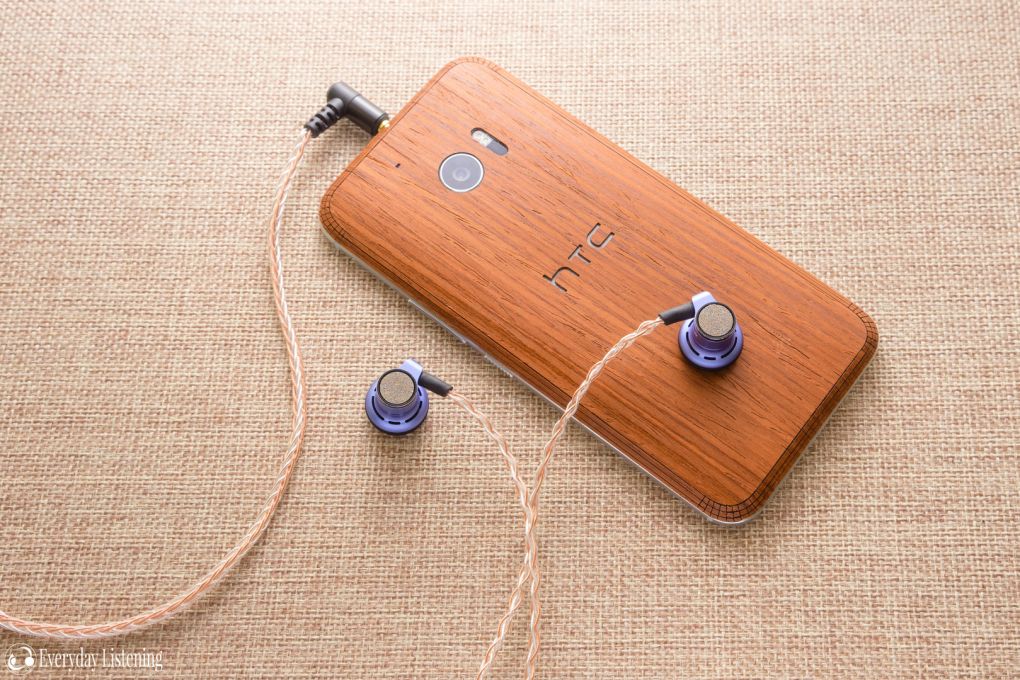
The Lyra Collection has a reasonable 32ohm impedance with a 108dB sensitivity. As a result, it is one of the more sensitive earbuds out there, delivering just slightly less volume than the lower-impedance Shozy earbuds. And, as the Lyra Collection assumes a single dynamic driver setup, it sounds fairly consistent between sources of differing output impedance. I didn’t find the Lyra to require additional amplification but due to its warmer tone and more laid-back midrange, I found best synergy with more neutral sources of high-resolving power.
HTC U11: The U11 has nice driving power for a smartphone but also a higher output impedance and a slight bass emphasis. Accordingly, the Lyra Collection sounded nicely balanced from the HTC but with noticeably heightened bass impact. Highs were also lacking some extension and detail but the overall image was sound. Dynamics and soundstage space did notably suffer, I would suggest that the dongle has a fairly mediocre channel separation.
Fiio X7 II: The X7 II provides a more neutrally orientated sound with hints of additional engagement. It provided a fine companion to the Lyra Collection, delivering great end to end extension and thus, high resolution. The X7 II pairing produced the most balanced sound with a large stage and accurate imaging. This was my preferred pairing used for review.
Hiby R6: The R6 is a slightly darker, fuller source but one with high resolving power. Unsurprisingly, it produced a darker sound than the X7 II; bass was slightly warmer and mids were slightly smoother but with simultaneously higher resolution. Treble had less air but a little more detail and bite around lower-treble. The Hiby’s higher output impedance didn’t hugely affect the Lyra Collection’s signature beyond the actual player’s signature.
Echobox Explorer: The Echobox is a vivid, U-shaped source with great driving power, this was also a nice pairing. The Explorer delivered increased bass impact and larger notes, with smooth but slightly recessed mids. It produced a more aggressive lower-treble presentation before a progressive decline into a neutral middle treble and slightly smoothed off upper-treble. As such, it has high attack and air but a dark background. However, it also missed out on some smaller background and micro details.
Comparisons –

Rose Masya ($110): The Masya doesn’t fit as well as the Lyra Collection due to its larger housings that sit shallower in the outer ear, but its design is just as distinct. The Lyra also has a far better cable as the unit on the Masya is quite tacky and thin. That said, the Masya’s cable is very supple and removable, a feature that the Lyra, and most earbuds in general lack.
The Masya produces slightly more bass extension with greater deep-bass emphasis. As a result, the Masya has more bass impact, but it has a very neutral if slightly attenuated mid and upper-bass presentation granting it a cooler tone overall. As such, the Lyra sounds fuller and more defined but the Masya does sound cleaner and more transparent if lacking density.
The Masya has much more midrange clarity at the cost of timbre; it’s just a little thin, bright and forward. The Lyra is more balanced but also a lot mellower; where the Masya is exceptionally revealing and clear, the Lyra is laid-back, warm and smooth. As the Lyra is more evenly weighted, it has notably more lower-midrange presence and body. Upper mids are slightly more present on the Masya, but similarly thinner than the Lyra. Clarity is excellent, but the Lyra’s sound is more natural and carries more detail even though it is more laid-back.
Treble is an interesting affair, the Masya is more aggressive and almost as well-extended but a lot less linear. The Masya has a neutral lower-treble response that offers slightly more attack than the Lyra. However, details are thin on the Rose earbud and the Lyra retrieves a lot more information. This is followed by a notable middle treble emphasis on both earbuds, the Masya especially so. Resultantly, both have a focus on air and space, but the Lyra is more balanced and more natural. The Lyra also has a little more extension, retrieving more micro-detail even though it isn’t as forward in its presentation.
Both the Masya and Lyra create huge soundstage presentations. The Masya has a slight edge in terms of width but lacks the depth of the Lyra. Most notable is imaging, the Masya sounds diffuse due to its thinner sound, lacking the foundation of the Lyra. As a result, the Lyra sounds a lot more coherent but the Masya does sound hugely separated. These are two different presentations, but ones with clear traits that enhance similar qualities. And though considerably more expensive, the Lyra does offer the refinement, balance and coherence that the Masya lacks.
Shozy BK ($160): The BK is smaller and has a slightly deeper fit. Both have excellent cables, but the unit on the Lyra is suppler. The BK’s plastic Yuin shells don’t offer much competition to the custom fabricated aluminium housings on the Lyra.
The Lyra has better sub-bass extension and delivers more impact as a result. It also sounds slightly tighter and more linear where the BK has a small mid-bass hump with relatively attenuated sub and upper-bass. As such, the Lyra is more defined and separated within the lower-frequencies but also tubbier due to its greater upper-bass emphasis. The BK is also a little faster and similarly well controlled so it sounds just as articulate if less dynamic.
The BK has a similarly balanced midrange, but lacks the added density of the Lyra. As such, it is more transparent and often a little more defined. It has slightly more lower-midrange presence and clarity on account of its more reserved upper-bass that mitigates spill and excessive colouration. By comparison, the Lyra Collection has a fuller lower-midrange, but also has higher resolution and better separation. That said, the BK sounds a little more focussed where the Lyra may be slightly too warm for some. Upper mids are more comparable, the Lyra has a little more presence but is slightly smoother and more laid-back.
Both have similar clarity, the BK sounds slightly more transparent due to its lesser upper-bass colouration and more neutral lower-treble. As a result, the BK has more treble attack but the Lyra Collection is easily the more detailed earphone. The BK also lacks a lot of the extension of the Lyra, smoothing off quickly after lower-treble. The Lyra resultantly has a lot more air and separation, it also retrieves a lot of background detail that the BK glosses over.
This culminates to a rather single-sided soundstage comparison. The Lyra is more spacious, more precise in its placement and more separated. The BK does have a little more midrange separation due to its higher transparency, but it lacks the end to end extension and resolution of the Lyra. Of course, it is just over half the price, but the Lyra offers more technical ability and much higher build quality without compromising the wonderful tonal balance of the BK.
Verdict –
The Lyra Collection is the most expensive earbud I’ve ever reviewed and easily one of the most premium models on the market. Diminishing returns is definitely in full effect, but there’s no denying that the Lyra delivers a strong performance; with much of the musical charm earbuds have become renowned for realised through great technical aptitude. The Lyra Collection also features a stunning build that matches and exceeds the meticulous machining of corporate giant 1More.

However, though very balanced and refined, the Lyra Collection does have some qualities that compromise transparency. Most notably, they have some upper-bass emphasis that makes their midrange quite full-bodied, and their smoothed-off lower-treble may lack some bite for clarity lovers. And, though undoubtedly outstanding amongst earbud, their comfort and cavernous soundstage will likely be their greatest asset compared to more resolving in-ears around the same price.
Verdict – 8/10, The Lyra Collection features a balanced sound and class-leading build. Though very price prohibitive, it is the most extended, detailed earbud I’ve tested yet and I don’t expect that to change in the near future.


2 thoughts on “Astrotec Lyra Collection 32ohm Review – Superior Expression” Leave a comment ›